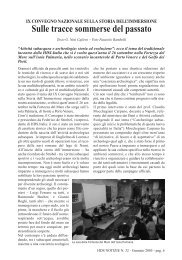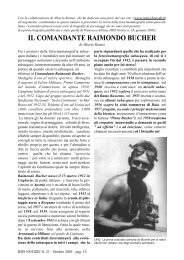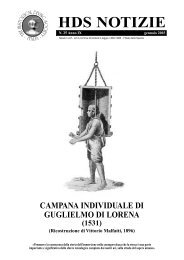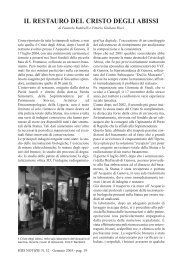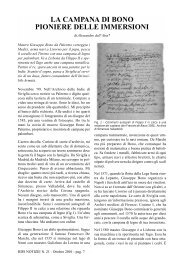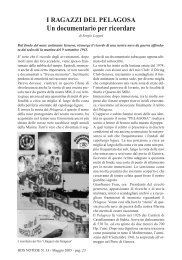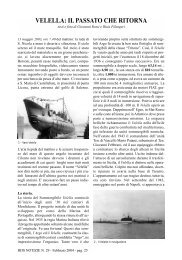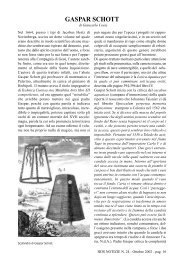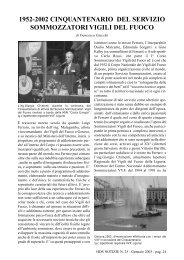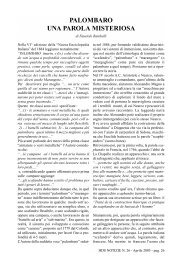Leggi l'intero numero - Historical Diving Society Italia
Leggi l'intero numero - Historical Diving Society Italia
Leggi l'intero numero - Historical Diving Society Italia
Create successful ePaper yourself
Turn your PDF publications into a flip-book with our unique Google optimized e-Paper software.
che mostrano alcuni uomini che nuotano con<br />
delle particolari appendici applicate agli stivali.<br />
Eppure bisogna arrivare al 1923, per veder realizzate<br />
le prime pinne da Le Corlieu, quelle<br />
pinne che ci permettono di muoverci sott’acqua<br />
con estrema facilità nelle tre dimensioni e che,<br />
dobbiamo riconoscerlo, sono la vera, unica,<br />
grande invenzione, in campo subacqueo, del XX<br />
secolo. Senza le pinne, ancor oggi, saremmo<br />
costretti a camminare sul fondale come i palombari.<br />
A completamento dell’equipaggiamento base<br />
manca solo la maschera, un articolo che, attualmente,<br />
è presente sul mercato in centinaia di<br />
modelli diversi tra loro per gusto estetico,<br />
campo di applicazione e portafoglio.<br />
Nel n° 20, luglio 2001, di HDS NOTIZIE è<br />
apparso un articolo a nome di Fabio Vitale, sulle<br />
prime vecchie maschere, presenti sul mercato<br />
italiano nel primo dopoguerra. In queste righe<br />
cercheremo, per quanto possibile, di percorrere<br />
la strada dell’evoluzione di questo oggetto, partendo<br />
dalle prime notizie di cui si è a conoscenza<br />
(sicuramente parziali e non esaustive).<br />
Ovviamente si è presa in considerazione la<br />
maschera in tutte le sue accezioni, dagli occhiali<br />
alla maschera semplice o al granfacciale, con<br />
evidente esclusione di ogni tipo di elmo che racchiude<br />
in se tutta la testa del subacqueo. Dunque<br />
vediamo:<br />
1331 – Ibn Battuta.<br />
Nel 1325 Ibn Battuta, nato in Marocco a Tangeri<br />
21 anni prima, da buon mussulmano inizia il suo<br />
viaggio di pellegrinaggio alla Mecca ma, evidentemente<br />
preso dallo spirito del viaggiatore in<br />
lui nascosto, protrae il suo viaggio per 29 anni<br />
fino al 1354, durante i quali visita l’equivalente<br />
di 44 Paesi attuali spingendosi oltre la Cina e<br />
l’Indonesia, percorrendo così circa 75.000<br />
miglia per terra e per mare, attraverso difficoltà<br />
e pericoli di ogni genere. Al suo ritorno in patria,<br />
su richiesta del Sultano, Battuta racconta la storia<br />
del suo lungo viaggio in un libro, ora conosciuto<br />
come “I viaggi (Rihala) di Ibn Battuta”.<br />
Durante il suo viaggio nel 1331 si trovò a passare<br />
per lo stretto di Hormuz, dove venne in contatto<br />
con i pescatori di perle. Così racconta<br />
Battuta di questa esperienza:<br />
“… gli abitanti di Siraf sono Persiani di nobile<br />
ceppo, e tra di loro c’è una tribù di Arabi, che si<br />
immergono per le perle. L’attività della pesca<br />
HDS NOTIZIE N. 28 - Novembre 2003 - pag. 7<br />
with fins, also if not exactly as we mean nowadays,<br />
with his head in an air container equipped<br />
with glass; as well as other drawings of a work<br />
of ‘500 kept at the Central Library in Zurich (ref.<br />
Hermann Heberlein “Le monde sous-marin –<br />
pages 52 e 56) that show men swimming with<br />
particular appendixes attached to the boots.<br />
Still we have to wait for 1923, to see Le Corlieu<br />
realising the first fins, the fins that allow us to<br />
easily move under water in three dimensions and<br />
that, we have to recognise this, are the real, only<br />
great invention of the XX century in the diving<br />
field. Without the fins, even today, we would be<br />
forced to walk on the bottom like the hardhat<br />
divers.<br />
In completion to the basic equipment the mask<br />
only is missing, an article that today is present<br />
on the market in hundreds of models different<br />
amongst each other for aesthetic taste, application<br />
field and wallet.<br />
In HAS NEWS n° 20, July 2001, a paper of<br />
Fabio Vitale appeared on the first old masks,<br />
present on the <strong>Italia</strong>n market of the first after<br />
war period. In these lines we will try, for how<br />
much is possible, to travel down the road of the<br />
evolution of this object, starting from the first<br />
known news (surely only partial and not exhaustive).<br />
Obviously the mask in all her meanings<br />
was taken into consideration, from swimming<br />
goggles to the simple mask to the full-face<br />
mask, with evident exclusion of every type of<br />
helmet that encloses al the diver head. We are<br />
then going to see:<br />
1331 – Ibn Battuta.<br />
In 1325 Ibn Battuta, born in Tangier, Morocco<br />
21 years before, as good Muslim starts his pilgrimage<br />
trip toward the Mecca but, obviously<br />
caught by the traveller spirit hidden in him, prolongs<br />
his trip for 29 year until 1354, during<br />
which he visits the equivalent of 44 current<br />
countries, going beyond China and Indonesia, in<br />
this way travelling around 75000 miles via land<br />
and sea, through any kind of difficulties and<br />
dangers. Upon his return to homeland, following<br />
a request of the Sultan, Battuta tells the story<br />
of his long trip in a book known today as “The<br />
travels (Rihala) of Ibn Battuta” (“I viaggi<br />
(Rihala) di Ibn Battuta”).<br />
During his trip in 1331 he found himself going<br />
through the Hormuz strait, where he came in<br />
contact with pearl anglers. Battuta tells us about



